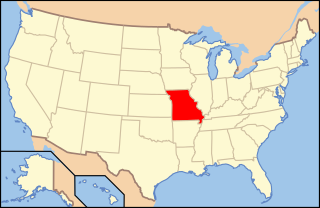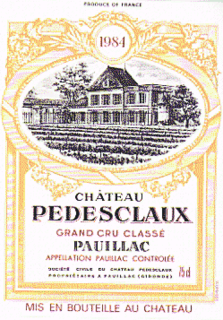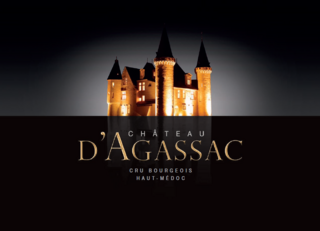
Missouri wine refers to wine made from grapes grown in Missouri. German immigrants in the early-to-mid-19th century, founded the wine industry in Missouri, resulting in its wine corridor being called the Missouri "Rhineland". Later Italian immigrants also entered wine production. In the mid-1880s, more wine was produced by volume in Missouri than in any other state. Before Prohibition, Missouri was the second-largest wine-producing state in the nation. Missouri had the first area recognized as a federally designated American Viticultural Area with the Augusta AVA acknowledged on June 20, 1980. There are now four AVAs in Missouri. In 2017 there were 125 wineries operating in the state of Missouri, up from 92 in 2009.

Château Pédesclaux is a winery in the Pauillac appellation of the Bordeaux region of France. The wine produced here was classified as one of eighteen Cinquièmes Crus in the Bordeaux Wine Official Classification of 1855.

Norton, a grape cultivar believed to be largely derived from Vitis aestivalis, is grown in the Midwestern United States, Mid-Atlantic States, northeastern Georgia, and, most recently, in California. Norton was first cultivated in Richmond, Virginia, and is the official grape of the State of Missouri and is considered the cornerstone of the Missouri wine industry. Strong evidence indicates that Dr. Daniel Norton first purveyed the Norton cultivar during the early 19th century from his vineyards in Virginia, USA. Further evidence has been reported that Dr. Norton developed the cultivar from seeds from a now extinct variety with unconfirmed parentage, Bland, pollinated by a Vitis Aestivalis grapevine. In 2009, Riedel designed stemware specifically for wine made from the Norton grape. The glass was unveiled at Les Bourgeois Winery near Columbia, Missouri.

The Missouri Rhineland is a geographical area of Missouri that extends from west of St. Louis to slightly east of Jefferson City, located mostly in the Missouri River Valley on both sides of the river. Dutzow, the first permanent German settlement in Missouri, was founded in 1832 by Baron von Bock. The area is named after the Rhineland region in central Europe, a wine-growing area around the Rhine river, by German-Americans who noticed similarities in the two regions' soil and topography.

Wine has been produced in the United States since the 1500s, with the first widespread production beginning in New Mexico in 1628. Today, wine production is undertaken in all fifty states, with California producing 84 percent of all US wine. The North American continent is home to several native species of grape, including Vitis labrusca, Vitis riparia, Vitis rotundifolia, and Vitis vulpina, but the wine-making industry is based almost entirely on the cultivation of the European Vitis vinifera, which was introduced by European settlers. With more than 1,100,000 acres (4,500 km2) under vine, the United States is the fourth-largest wine producing country in the world, after Italy, Spain, and France.

Illinois wine refers to any wine that is made from grapes grown in the U.S. state of Illinois. In 2006, Shawnee Hills, in southern Illinois, was named the state's first American Viticultural Area. As of 2008, there were 79 wineries in Illinois, utilizing approximately 1,100 acres (4.5 km2) of vines.
Carmel Winery is a vineyard and winery in Israel. Founded in 1882 by Edmond James de Rothschild, its products are exported to over 40 countries. It is the largest winery in Israel, with a local market share of almost 50%.
Napa Valley AVA is an American Viticultural Area located in Napa County in California's Wine Country. Napa Valley is considered one of the premier wine regions in the world. Records of commercial wine production in the region date back to the nineteenth century, but premium wine production dates back only to the 1960s.
The Santa Cruz Mountains AVA is an American Viticultural Area centered on the Santa Cruz Mountains. Its territory expands in three California counties, Santa Clara, Santa Cruz and San Mateo. Established in 1981 by the Alcohol and Tobacco Tax and Trade Bureau (TTB), Santa Cruz Mountains AVA was among the first to be defined by its mountain topography. Based on elevation, it largely follows the fog line along the coast, extending down to 800 feet (240 m) on the eastern slope toward San Francisco Bay, 400 feet (120 m) on the western slope to the Pacific Ocean and extending toward the ridgecrests at 3000+ feet elevation.

The Sierra Foothills AVA is an American Viticultural Area in the foothills of the Sierra Nevada in the state of California in the United States. Wine grapes were introduced to the area in the nineteenth century during the California Gold Rush. Over 100 wineries are located within its boundaries.

Nebraska wine is wine made from grapes grown in the U.S. state of Nebraska. Nebraska's oldest winery was founded in 1994, and about thirty-five commercial wineries operate across the state. Wine quality varies across the state, however several wineries have won Best of Show titles during the States first 25 years of commercial wine production. Five of those titles were won with wines made of the states #1 wine produced from the Variety Edelweiss. Other wins were made with a dry Brianna, Vignole and a Marechel Foch Rose' wine. The vast majority of these wineries are small and sell most of their wine to tourists who visit the winery in person. The University of Nebraska–Lincoln has a program in viticulture. There are no designated American Viticultural Areas in Nebraska.

Wyoming wine refers to wine made from grapes grown in the U.S. state of Wyoming. There are no designated American Viticultural Areas in Wyoming. The state has two commercial wineries, Table Mountain Vineyards in Huntley and Wyoming Wine in Sheridan. Table Mountain Vineyards is Wyoming's largest with a 10-acre (40,000 m2) vineyard and produced 3,000 gallons in 2007 from 100% Wyoming grapes. The winery helped pave the way for the Wyoming Grape and Wine Association (WGWA) which focuses on expanding and developing the Wyoming grape industry. Table Mountain Vineyards has paired up with several wineries in western Nebraska to promote wineries along the historic emigration trails, including the Oregon Trail.

The Hermann AVA is an American Viticultural Area located in Gasconade County, Missouri, and entirely contained within the larger Ozark Mountain AVA. The wine appellation is located on the southern side of the Missouri River near the town of Hermann, about halfway between St. Louis and Jefferson City. The AVA covers the northernmost hills of the Ozark Plateau with many of the 200 acres of vineyards planted along hillside locations. As of 2007, seven wineries were producing wine in appellation, including Missouri's largest winery, Stone Hill Winery.
Médoc is an AOC for wine in the Bordeaux wine region of southwestern France, on the Left Bank of the Gironde estuary that covers the northern section of the viticultural strip along the Médoc peninsula. The zone is sometimes called Bas-Médoc, though this term is not permitted on any label. With few exceptions there is produced only red wine, and no white wine has the right to be called Médoc.

Haut-Médoc is an Appellation d'Origine Contrôlée (AOC) for wine in the Bordeaux wine region of southwestern France, on the Left Bank of the Gironde estuary. Covering a large part of the viticultural strip of land along the Médoc peninsula, the zone covers approximately 60 kilometres (37 mi) of its length.
Château La Tour de Mons, archaically named Tour de Marsac, is a winery and wine from the appellation Margaux, located in the Left Bank of the Bordeaux wine region of France, in the commune of Soussans. The wine was rated Cru Supérieur in the Cru Bourgeois classification of 1932, and through later revisions until the temporary annulment of the classification in 2007.
St. James Winery is located in St. James, Missouri, near mile marker 195 of Interstate 44. The winery distributes 200,000 cases of wine per year in 19 states. The vineyards are composed of 180 acres (73 ha) of Catawba, Vignoles, Chardonel, Concord, Norton, Chambourcin, Seyval and Rougeon grapes. The winemaking heritage of the area was both started and subsequently influenced by Italian Immigrants in the late 19th century. The company has over 50 employees working in the Cellar, Administration, Tasting Room, Shipping and Vineyard departments. The winery distributes in nine U.S. states, mostly in the Midwestern and Southern portions of the country.

Château Chambert-Marbuzet is a Bordeaux wine estate of 5 hectares located in the St.-Estèphe appellation area. It belongs to the family of Henri Duboscq.

Château D'Agassac is a Haut-Médoc wine estate located on the village of Ludon-Médoc in the Médoc, only 15 minutes from the city of Bordeaux in France. Its red wine is a famous Cru Bourgeois ranked "Cru Bourgeois Exceptionnel" in the historic Bordeaux Wine Official Classification of 1932. The property is also a leader in enotourism.













